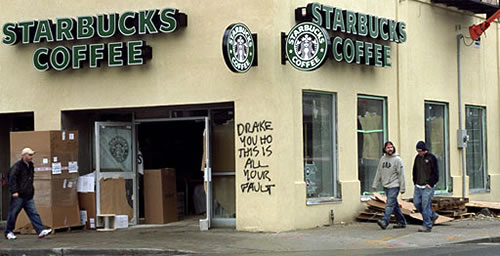In my entry about the King Street West cafe called “Journo”, I mentioned that I’d write about gentrification, Starbucks and its malcontents and “coffee coding”. I still plan to do that, but thought that I should post an entry that’s been sitting in draft form for far too long. I think it makes a decent introduction to what I’ll eventually be talking about.
Those of you who frequent the “West Queen West” area of Accordion City are probably familiar with the “Drake, you ho” graffito on the nearby still-under-construction Starbucks from late November:

For those of you not familiar with the area, the “Drake” being referred to is the Drake Hotel,
a former flophouse hotel that underwent — with a lot of money — a
metamorphosis into a hip boutique hotel that’s attracted a “beautiful
people” crowd to a neighbourhood that used to be known for crack
dealers, real honest-to-goodness actual-not-metaphorical hos and bums who emanated a stench that carried a far greater distance thanyou might imagine.
The
Drake’s renovation has inspired the Gladstone Hotel,
a stone’s throw away, to also become a boutique hotel too — from one that wasn’t as outright awful as the Drake used to be, to one not quite on par with the Drake. The Gladstone, for
those who don’t know, is home to a popular karaoke venue where
slum-dwellers and slummers
intersect. Other businesses, either inspired by the neighbourhood’s sea
change, are moving in or moving up — witness places like Lot 16 Bar and the Beaver Cafe. Starbucks is the first yuppie chain to set foot in the area, and it may not be the last.
I grew up in Toronto and remember what the neighbourhood was like back in
the 1980s: sheer, don’t-go-there-at-night crap. My sister’s boyfriend
lived within falling distance of the old “Video Time” sign near Queen
and Dovercourt, and while waiting for him to let her in, often put up
with propositioning from johns and sleazy dealers. The neighbourhood,
Parkdale, was often known by its nickname, “Crackdale”
In the area, around the time
I started playing accordion — the spring of ’99 — I got into a fight with some street urchin
who first spat at me for being a “chink taking away our jobs” and then
tried to make off with my bike. I nailed him in the right temple with
my Kryptonite lock (for the bike theft) and when he hit the pavement,
kicked him in the face (partly for the slur, and partly to make sure he stayed down).
I also corrected him: “I’m a flip, not a chink. You wanna be a racist, get your terms right.”
Needless to say, having had these experiences, working right by the
neighbourhood (Tucows is a hop, skip and a jump south) and being on my particular rung of
the socio-economic ladder, I’m a big fan of the clean-up. The
graffito’s author, less so.
A roughly analogous neighbourhood in the New York City area, Brooklyn’s
Williamsburg, is undergoing an incursion by another chain: Subway.
Here’s a poster that’s been popping up in the area:

For more, see Curbed’s entry, Daily Dose of Corporate Hate: Subway in the ‘Burg.




